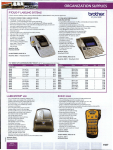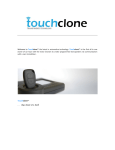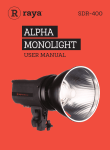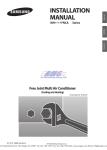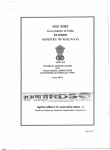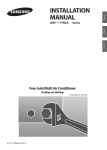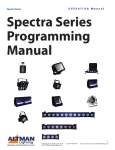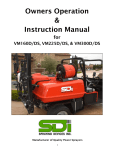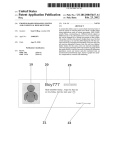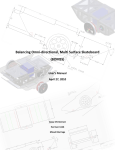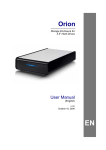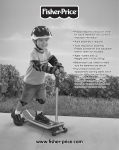Download User`s Manual
Transcript
Thank you for your purchase of the Swagway X1! To ensure your safety and the
safety of others, please read and follow these instructions. Happy riding!
User's Manual
• Thank you for choosing the Swagway X1 self-balancing electric skateboard.
• The Swagway is the next step in the evolution of transportation. We take the fun of a
skateboard, make it as easy to use as a motor scooter, then give it an extra bit of
swag.
• Before operating this vehicle, read all the instructions for safe assemb ly and
operation.
• This User's Manual will guide you through the functions and usage of your
Swagway. Have fun!
It is important that you follow all safety warnings that appear throughout your Swagway
Hands-Free smart board manuals and that you use good judgment when you ride your
Swagway. If you have questions, or do not have the Swagway Manual or Safety Video,
contact Swagway before you attempt to use your Swagway board.
The Swagway is a self-balancing, personal transporter that uses balancing technology.
Note: Balancing technology cannot prevent injury if you do not ride the Swagway safely. Please review the below safety
warnings.
• Always wear shoes, a helmet, and appropriate safety gear such as knee and elbow pads when riding. Use an
approved bicycle or skateboard helmet that fits properly with the chin strap in place, and provides protection for
the Front, back and sides of your head.
• Do not ride without proper training, please review manual and how to videos before use.
• Avoid obstacles and slippery surfaces that could result in a loss of balance or traction and cause a fall.
• Do not ride at high speeds, on uneven terrain, or on slopes. Do not perform stunts or turn abruptly.
• Never place anything on the rider detection pads except your feet. Doing so could interfere with the Rider
Detection system and may allow the Swagway to travel on its own, risking running into a person or property and
causing injury or damage.
• Never step off of the Swagway when it is in motion. If you step off of the Swagway while in motion, you risk injury
to yourself, others, and damage to the Swagway.
• Although the Swagway is designed to be as stable as possible for a design that utilizes two self-balancing wheels,
it is possible to “override” the Swagway and tip over when riding too fast for the conditions. Always be aware of
the riding surface and environmental conditions while riding. Be alert. Scan both far ahead and in front of the
Wheels—your eyes are your best tool for safely avoiding obstacles and slippery surfaces.
• Do not carry one or more passengers.
• Do not ride your Swagway after consumption of alcohol, drugs, or while intoxicated. You must comply with local
laws and give way to pedestrians.
• All riders must be over 4’ tall and must weigh more than 44 lbs. The maximum weight limit 220 lbs.
RISK OF DEATH OR SERIOUS INJURY
Assumption of Risk: By riding our Swagway the user acknowledges and accept responsibility of all risks associated with
the use of the Swagway Hands-Free Smart Board, which may include, but are not limited to, muscle injuries, broken
bones, lacerations, serious injury, and possibly death, which may be sustained while using the Swagway. To ride safely,
you must read and follow all instructions and warnings in the User Manual.
Chapter I General information-----------------------------------------------------------------------------------1
1.1 About the manual----------------------------------------------------------------------------------------1
1.2 The risk of driving-------------------------------------------------------------------------------------1
1.3 Before you begin----------------------------------------------------------------------------------------1
1.4 Important information-----------------------------------------------------------------------------------1
CATALOG
Chapter I General information- -- - -- - -- - --- --- --- --- --- --- --- --- --- --- --- --- -- - -- - -- --- --- -- - 3
Product
introduction---------------------------------------------------------------------------------23
manual-----------------------------------------------------------------1.Chapter
1 AboutIIthe
Description---------------------------------------------------------------------------------------------2
1. 2 The2.1
risk
of driving - - - - - - - - - - - - - - - - - - - - - - - - - - - - - - - - - - - - - - - - - - - - - - - - - - - - - - - - - - - - - - - - - 3
2.2 Diagram-------------------------------------------------------------------------------------------------3
1. 3 Before
youit begin
- --- ------ -- --- -- - -- - -- - -- - -- - -- - --- --- --- --- - -- - -- - -- - - -- - -- - -- - - 3
2.3 How
works--------------------------------------------------------------------------------------------4
1. 4 lmportantinformation ------------------------------------------------------------- 3
III Control
and indicators------------------------------------------------------------------------------5
Chapter Chapter
II Product
Introduction-- -- - -- - -- - -- - -- - -- - -- - -- - --- --- --- --- --- - -- ----- --- --- --- -- 4
2. 1 Descrtptlon------------------------------------------------------------------------4
3.1 Pedal sensor--------------------------------------------------------------------------------------------5
2.2 Diagram------------------------------------------------------------------------5
3.2 Indicator lights----------------------------------------------------------------------------------------6
2. 3 How
it
works
----------------------------------------3.3 The remote control--------------------------------------------------------------------------------------106
Chapter Ill Control and indicators --------------------------------------------------------- - 7
Safe Use-------------------------------------------------------------------------------------------7
3. 1 Chapter
RemoteIVcontrol
- --- -- --- --- --- --- --- --- --- --- --- ----- --- --- -- - -- - -- - -- - -- - -- - -- - -- · 7
4.1 sensor
The weight
3. 2 Pedal
- - - limit---------------------------------------------------------------------------------------7
-- --- --- --- --------- --- --- -- --- --- --- --- --- --- --------------------·8
4.2 Range per charge---------------------------------------------------------------------------------------8
3.3 Indicator-------------------------------------------------------------------------- 8
4.3 Max. speed---------------------------------------------------------------------------------------------8
Chapter IV Safe
- --- --- ------------ -- --- --- ------------------- --- --- ------------------· 9
4.4 Use
Max. incline-------------------------------------------------------------------------------------------8
4. 1 The weight limit ------------------------------------------------------------------- 9
Learning
use it-----------------------------------------------------------------------------------9
4 . 2 Chapter
Range Vper
chargeto-----------------------------------------------------------------10
5.1 Operating steps----------------------------------------------------------------------------------------9
4. 3 Max.
speed - - - - - - - - - - - - - - - - - - - - - - - - - - - - - - - - - - - - - - - - - - - - - - - - - - - - - - - - - - - - - - - - - - - - - - ·1O
5.2 Diagram of operation-----------------------------------------------------------------------------------10
Chapter V Learning
to use it ----------------------------------- - -- - ----------------------- 11
5.3 Calibration--------------------------------------------------------------------------------------------11
5. 1 Operating
steps- - - - - - - - - - - - - - - - - - - - - - - - - - - - - - - - - - - - - - - - - - - - - - - - - - - - - - - - - - - - - - - - - - 12
5.4 Safety guidelines--------------------------------------------------------------------------------------12
5. 2 Safety guidelines--- --- - - -- - -- - -- - --- --- --- --- --- --- --- --- --- --- --- --- --- --- --- ----14
5. 3 Practicing - --- -- ---· -- --- --- --- --- --- --- --- ------------------ --- --- --- --- --- --- --- -15
-01-
Chapter Vl Safe driving------------------------------------------------------------------------------------------14
Chapter VII Battery usage--------------------------------------------------------------------------------------16
7.1 Battery capacity------------------------------------------------------------------------------------16
7.2 Charging steps--------------------------------------------------------------------------------------17
7.3 Battery temperature-------------------------------------------------------------------------------18
7.4 Battery specifications------------------------------------------------------------------------------18
7.5 Transporting the battery--------------------------------------------------------------------------19
Chapter VIII Maintaining your Swagway----------------------------------------------------------------------20
8.1 Cleaning---------------------------------------------------------------------------------------------20
8.2 Storage----------------------------------------------------------------------------------------------20
Chapter IX Specifications---------------------------------------------------------------------------------------21
Chapter X Packing list-------------------------------------------------------------------------------------------23
Warranty Registration Card-------------------------------------------------------------------------------------24
Have a safe, fun ride!
Chapter I General Information
1. 1 About the manual
Before operating this vehicle, read all the instructions for safe assembly and operation.
This User's Manual will guide you through the functions and usage of your Swagway electric skateboard.
If you have any questions or you cannot find the information you need in the manual, please contact your
place of purchase or our company immediately.
1. 2 The risk of driving
The Swagway is a self-balancing smart transportation and recreational device. It has gone through
rigorous testing to ensure its safety. However, if you don't follow the instructions in the manual, you may be
injured.
&WARNING!
No matter when and where, there is a possibility you may crash, fall off, lose control, etc., causing
injury and even death. In order to avoid being injured, please read this manual carefully.
1. 3 Before you begin
Before using, check that the battery is fully charged. Please find more details in Chapter VII. The likelihood
of injury or death will increase if you don't follow the proper operating instructions in this manual.
1. 4 Important information
When reading this manual, please pay attention to 'WARNING' and 'NOTE' in all capital letters.
C aution: read and understand the following or you may be injured.
The following explanation requires your attention.
-01-
Chapter II Product introduction
2.1 Description of the Swagway
The Swagway is a self-balancing electric skateboard which can go forwards and backwards. It's steering
and stopping are controlled by Dynamic Equilibrium. It is simple to operate, easy to control,
environmentally friendly, and looks incredibly cool!
-02-
2. 2 Swagway Diagram
Fender
Tire
Pedal
Indicator
Directional Indicator Light
-03-
Protective cap for chassis
2. 3 How it works
• The Swagway self-balances and moves because of Dynamic Equilibrium. It uses an internal
gyroscope and acceleration sensors to move based on your center of gravity. When you lean
forward, it will sense your actions and accelerate. When you need to turn, slow down and gently
shift the weight on your left or right foot to turn the opposite direction.
• The Swagway has an inertial dynamic stabilization system that keeps you upright. However, it
will stop detecting you if you lean too far left or right or you take a foot off the board. Slow
down before turning or you will fall off and be injured.
..
-04-
Chapter Ill Control indicators
3.1 Pedal sensor
The Swagway has 4 sensors below the pedals. When the operator steps on a pedal, the Swagway will
adjust itself to balance automatically.
When riding the Swagway, you must make
sure that you are touching the pedals.
Please don't step on the part outside the
pedal; it won't detect you. Do not lean too
far back or forward, and do not ride on a
slope.
Don't put objects on the pedals. The
Swagway will not lock, increasing the
possibility that it will drive off and crash into
something, damaging the Swagway and
possibly causing injury.
-05-
Do not step on the center pivot point of
the Swagway. This is dangerous, and
may break your Swagway.
3.2 Indicator lights
The indicator lights are located in the middle of the Swagway.
• Battery indicator: A green light means the battery is fully charged. When the light flashes green, that
means there is 50% battery life remaining. When it
turns red and is beeping it is below 20% battery life.
Stop using the Swagway immediately and
recharge the battery.
• Operation indicator: When the pedal is triggered,
the operation indicator will light up green to show
that the system is operating normally. If the system
experiences an error, the indicator will turn red.
Immediately get off the Swagway
if the low battery indicator
comes on. The Swagway will not
self balance and you will fall.
-06-
Chapter IV Safe Use
We sincerely hope every operator can ride the Swagway safely and enjoy it. Think back to when you
learned to ride a bike, drive a car, go skiing or skateboarding, etc. Remembering those experiences will
help you learn how to master your Swagway faster.
• Follow this User's Manual to learn to ride the Swagway safely. We highly advise you read the manual
carefully the first time. Before riding, make sure the tires are undamaged and mechanical parts
are not loose. If there is anything abnormal, please contact us for repair immediately.
• Please read the manual carefully. It covers lots of important information, including speed
limitations, indicator warnings, how to turn off safely, etc.
• Please never use the Swagway to do anything that may cause personal injury and property damage.
• Please don't modify the mechanical parts of the Swagway. This is a high tech, precision device. Any
modifications can cause unexpected results, breaking the Swagway or causing injury.
4.1 Weight limitation
• The reason for the weight limitation:1. To guarantee the safety of the operator; 2. To ensure the
Swagway operates properly.
• Maximum load: 220 LBS (100 KG)
• Minimum load: 44 LBS (20KG)
&_WARNING! If the Swagway is overloaded, you may fall off and be injured.
-07-
4.2 Range per charge
The range per charge is related to many factors.for example:
• Topography: On smooth even road, the range per charge will increase. If you are on rough
terrain or on a slope, it will decrease.
• Weight: The weight of the operator will influence the driving distance.
• Temperature: If the Swagway gets too hot or too cold, it will decrease the driving distance.
• Maintenance: If the Swagway is charged properly and the battery is kept in good condition, the
driving distance will increase. Improper charging and maintenance will decrease the driving distance.
• Speed and driving style: keep a moderate, consistent speed to increase the driving distance.
Frequently starts, stops, acceleration, and deceleration will reduce the driving distance.
4.3 Max. Speed
• The maximum speed of the Swagway is 1 O mph (16 km/h).
• When the operator exceeds the maximum speed, the Swagway will sound an alarm.
• At recommended speeds, the electric Swagway will balance itself well. When the speed is faster
than the recommended speed, you will lose balance and fall off.
4.4 Max. Incline
• Do not operate on hills or slopes of more than 30° incline.
• At recommended inclines, the electric Swagway will balance itself well. When the incline is
steeper than recommended, you will lose control or fall off.
-08-
ChapterV Learning touseit
This User's Manual includes instructions and notes; the operator must read it carefully and follow these
instructions. It is very important for you to know all these rules.
5.1 Operating Steps
Step 1 : Press the power switch to turn on the Swagway.
Step 2: Get ready to drive. First, step on one pedal to trigger the foot-switch. The system will enter
self-balancing mode. T hen step on with your other foot.
Step 3: Stand upright but relaxed. Do not make any sudden or jerky movements. Shift your weight forward or
back to control the Swagway.
Step 4: Shift your weight to turn. Putting more weight on your right foot turns left. Putting more
weight on your left foot turns right.
Step 5: Get off. Before you get off, make sure that the Swagway is stopped, then step off one
c
foot at a time. Please be careful.
[) NOTE:
If the Swagway doesn't self-balance when you trigger the foot-switch, the warning LED will light. Do
not operate the Swagway. Wait a few minutes and try again. If you are on a slope, move the Swagway
to flat ground. If this continues, please contact technical support. DO NOT OPERATE!
-09-
..
5.2 Diagram of operation
fil WARNING!
Do not turn suddenly while driving fast, accidents will result.
Do not ride sideways or turn on a slope. The self-balancing sensors will
malfunction, jeopardizing your safety
-10-
5.3 Calibration
If your Swagway seems to pull to the left or right, you may need to recalibrate its
sensors. The process requires two levels, available at any hardware store.
Many smartphones have free
"bubble level" apps as well.
Step 1 : Start with the Swagway powered off.
Step 2: Place each level parallel with the wheel touching the inside of the wheel base.
Step 3: Rotate the Swagway until both levels on each wheel base are level. If you do not have a level,
make sure both platforms are equal with each other and level to the ground as best as possible.
Step 4: While keeping the Swagway level, hold the power button down. The Swagway will make the
normal power on tone. Wait 3 seconds and you will hear a single beep. Release the power
button. Front LEDs will begin flashing. Power the Swagway off.
Step 5: Power on again. The Swagway should now be calibrated. If the Swagway is still not calibrated
correctly, go to step 1 and begin making minor adjustments.
-11-
5.4 Safety Guidelines
• During operation, if the system encounters an error or is being operated incorrectly, the Swagway will
alert the operator. It will sound an alarm and light error indicator LEDs.
• When you step on the Swagway the platform may tilt forwards or backwards up to 10 degrees. It will
not function if it tilts more than that.
• The Swagway will not function if the voltage of the battery is too low.
• The Swagway will not function during charging.
• The Swagway will not function if it flips upside down.
• The Swagway will not function if you are going too fast.
• The Swagway will not function if it is shaking too much, like if you are on uneven or rocky ground.
• If the battery voltage is too low, 15 seconds later the Swagway will enter into power off mode to
protect the battery.
• If the battery is over-worked, like when climbing a very steep slope, 15 seconds later the Swagway
enters into power off mode.
-12-
&WARNING!
When the Swagway enters into a shutdown state, the system will lock down the machine
automatically. It can be unlocked when you press the unlock button. When the battery has been
depleted or an error alarm or indicator light goes off, please do not continue to drive the Swagway.
The self-balancing may malfunction and the driver is likely to be harmed. If the battery reaches
minimum capacity, the continued driving of the Swagway will reduce the battery's life.
Practicing
Before you drive the Swagway outdoors, please make sure you are familiar with the skills of driving it:
• Wear casual clothing and flat shoes to maintain your flexibility and stability.
• Please practice in open spaces until you can easily get on, move forwards and backwards, turn,
stop, and get off easily.
• Make sure the pavement is even. Do not drive on a slope until you are experienced.
• The Swagway is designed for smooth road. When driving on uneven pavement, the user should
slow down. Be careful or the Swagway will lift off the ground.
• If you are unfamiliar with the Swagway, avoid driving in places with pedestrians or obstacles.
• Be careful going through doors; you are 4 inches taller than normal and might hit your head.
-13-
Chapter VI Safe driving
This chapter will focus on safety knowledge and warnings. Before operating this vehicle, read all the
instructions for safe assembly and operation. This User's Manual will guide you through the functions and
usage of the Swagway. To ensure the best driving experience, read the user manual carefully before
driving.
1¥tMM@
• Before you start, familiarize yourself with the operating instructions so that you can keep the Swagway
in the best condition. Otherwise you may crash, fall off, lose control, etc.
• When you are learning to use the Swagway, make sure that all safety measures are made. Wear
a helmet, knee pads, elbow pads, and other protective gear.
• The Swagway is only for personal entertainment. You may not be allowed to ride it on sidewalks
and streets. Check your local laws first.
• Do not ride in traffic.
• Children, the elderly, and pregnant women should not drive the Swagway.
• Do not drive while intoxicated or under the influence of medication or drugs. It is dangerous and illegal.
• Do not carry items when driving.
• When driving the Swagway you must comply with local laws and give way to pedestrians.
• Please be alert to your surroundings to ensure a safe ride. Do not drive in dimly lit or dark places.
• Relax your legs while driving, knees slightly bent. This helps maintain balance when you encounter
uneven ground.
• Make sure your feet are always on the pedals. Taking your feet off the Swagway while driving is
incredibly dangerous.
• Please wear appropriate clothes and safety gear, this will help you handle emergencies better.
• The Swagway can only support one person. Do not let two or more people ride it.
• Do not start or stop suddenly.
• Avoid driving on steep slopes.
-14-
• The weight of the user and their belongings should not exceed the maximum load indicated in the
instructions, otherwise you may damage the Swagway, or the driver may fall or be injured. The driver's
weight should not be less than the minimum weight as marked in the instructions. Otherwise the
Swagway will be difficult to control. This is especially true when riding downhill, as the Swagway may
reach unsafe speeds.
• Ensure the vehicle speed is safe to yourself and others, and be ready to stop at any time.
• When you are in an accident, please contact EMS / 911 right away.
• When you and your friends are driving Swagways near each other, please keep a safe distance from
each other to avoid collisions.
• When going through doors, remember you are four inches (10 cm) taller on the Swagway.
• When steering, pay attention to your body's center of gravity. A sudden shift may cause you to fall.
• Do not ride in the rain. Do not ride backwards for long distances or at high speeds. Be especially
careful when riding backwards and turning.
• The Swagway is not a medical mobility device. Be sure you are healthy enough to ride it.
• Avoid driving over obstacles and slippery ground such as snow, ice, and wet surfaces.
• Avoid driving on items made of cloth, small branches, and stones.
• Avoid driving in narrow spaces or where there are obstacles.
• Only drive the Swagway where permitted. Local laws may restrict where you can ride.
• Do not operate near flammable vapor, liquids, dust or fibers, and other fire hazards.
Remember, the Swagway is a motor vehicle, and is treated as
such by local law. You can and will be arrested for Drunk
Driving. Many cities have restrictions on where you can
drive motor vehicles, and additional restrictions on driving
non-automobiles on streets and highways.
Always wear a helmet and appropriate safety gear. We are not responsible
for injury or accidental death.
-15-
Chapter VII Battery Usage
This chapter mainly discusses the charging methods, how to maintain the battery, the safety issues you
need to pay attention to, and the battery specifications. For the safety of yourself and others, and to
extend the battery's life and improve battery performance, please be sure to observe the following
instructions.
7.1 Low battery
When you find the battery indicator is red, it indicates low battery. It is recommended that you stop
driving. When the power is low, there is not enough energy for normal driving. The system will
automatically stop and tilt the base of the platform to discourage you from using it. It is very easy to fall if
you insist on driving at this time, and it will also affect the battery's life.
• Do not use the battery in the following cases.
1. It is giving out some odor or excessive heat.
2. Something is leaking.
• Disassembly and battery maintenance should only be performed by an authorized professional.
• Do not touch any substance leaking out of the battery.
• Do not let children and animals touch the battery. Before installing the battery, disconnect the
charger. When charging, you may not operate the Swagway.
• Batteries contain dangerous substances inside. Do not open the battery. Do not insert anything into
the battery.
• Only use chargers offered by our company.
• Over-worked lithium batteries can explode. Excessive discharge due to modification (over-volting)
is dangerous. Do not dispose of in fire.
• Battery operated motor vehicles can only be used under the permission of the local law.
-16-
7. 2 Charging steps
• Locate the charging port on the back of the Swagway.
• Ensure the charging port is dry.
• First plug the charger into the wall (1 OOV-240V; 50,60Hz). Verify the green light lights up, then plug
the other end of the charger into the Swagway.
• The red indicator light on the charger indicates that it is charging properly. If the light does not
come on, check that the charger is connected securely to the wall and to the Swagway.
• When the indicator light changes from red to green, the battery is fully charged. Please stop charging.
If you keep it on the charger, it will reduce the battery life.
•
•
•
•
Please charge and store in accordance with these instructions, otherwise it will damage the battery.
The charging time is approximately 2 hours. Charging longer than that will affect the battery's life.
Please keep the charging environment clean and dry.
If the charging port is damp, don't charge it.
-17-
7.3 Battery temperature
• If you want the Swagway to operate efficiently, the battery temperature must be within the following
range.
• The temperature before and while charging must be within the recommended values. The charging
efficiency is the highest when the battery is near the recommended temperature. If it is too cold or
hot, the charging time will be longer, or the battery will not fully charge.
7. 4 Battery specifications
NAME
PARAMETERS
Battery
lithium-ion battery
Charging Time
2 ~ 3Hours
Voltage
36V
Initial Volume
4.4AH
Working Temperature
5°F ~ 122°F (-15°C ~ 50°C )
Charging Temperature
32°F ~ 104°F (0°C ~ 40°C)
Relative Humidity of Storage
5% - 95%
-18-
7 .5 Transporting the battery
_& WARNING!
Lithium batteries are considered hazardous materials. Transporting it is governed by federal,
state, and local laws.
Q NOTE:
International law prohibits shipping bare lithium batteries. If you ship your Swagway, you
must ship it with the battery installed. You may not ship the battery separately.
-19-
Chapter VIII Maintenance
Your Swagway needs to be maintained. T his chapter mainly describes the relevant steps to maintain it,
along with tips and reminders to keep your Swagway running properly. Please make sure that the power
and charge coil are off before you perform the following. Do not perform any maintenance when the power is
on or the battery is charging.
8.1 Cleaning
• Make sure the power and the charge coil are off.
• Wipe the outer shell of Swagway with a soft, dry cloth.
r�mo@ma·
• The Swagway meets IP54 water-resistance. It can withstand small splashes, but do not submerge.
• Do not let water or liquids get into the Swagway. It will cause permanent damage to the
internal electronics. Wipe all dirt from your Swagway, and do not store in a dusty environment.
8.2 Storage
• Before storing, fully charge the Swagway to prevent battery over discharge due to non-use.
• If stored more than one month, remove the battery. Discharge and recharge the battery every three
months.
• If the storage temperature is below 32º Fahrenheit (Oº Celsius), please don't charge the Swagway. Put it
in a warm environment {higher than 50º Fahrenheit (10º Celsius) and let it warm up before charging.
• Cover the Swagway to keep dust out. Dust and sand can get in the motor and cause problems.
• Store indoors at a dry and suitable temperature. Do not store in an unheated garage or shed.
fi..f(Wii@
• Only authorized repair centers may open and service the Swagway. Attempting to repair or modify your
Swagway voids all warranties.
-20-
4 IN
7 IN
Chapter IX Specifications
584 MM
23 INCHES
-21-
Specifications
Comments
Name
Parameter
Nat Weight
22 LBS
Minimum Load
44 LBS
Maximum Load
220 LBS
Maximum Speed
10MPH
Distance varies depending on terrain, driving style and load.
Range Per Charge
9.3-12.4 MI
Depending on load.
Climbing Capacity
15"
Turning Radius
o·
Energy
Rechargeable Li-ion Battery
Charger Voltage
100-240V 50-SOHZ
Dimension
23 x 4 x 7 IN
Chassis Haight
1.18 IN
Pedal Haight
4.3 IN
Tire Type
Hard Rubber Tire
-22-
Chapter X Packing list
NO.
Name
Quantity
1
Swagway X1 electric skateboard
1
2
Charger
1
3
Manual
1
Have a Safe, Fun Ride!
-23-





























